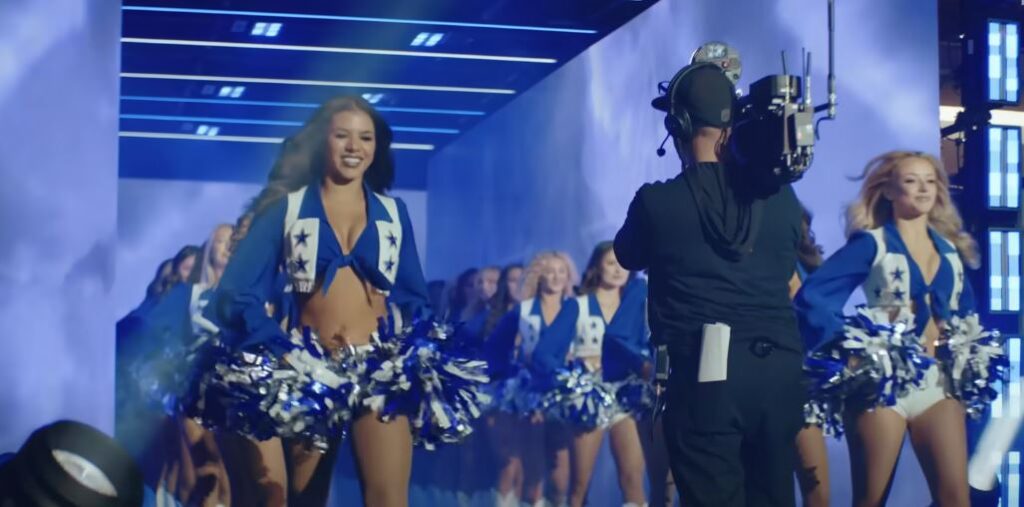
The Dallas Cowboys Cheerleaders’ pay raise over the past year has emerged as a pivotal point in the continuing discussion concerning media influence, wage equity, and the underappreciated work that goes into professional glamour. The cheerleaders have received a 400% pay increase after decades of underpayment, which has a remarkable impact on changing the perception of female entertainers. It took years of legal action, social media awareness, and a particularly helpful boost from Netflix’s highly visible docuseries for this leap to happen.
America’s Sweethearts turned the DCC into more than just a brand by highlighting the individual lives, sacrifices, and athletic prowess of each team member. They portrayed them as highly accomplished professionals who work under tremendous pressure, but they are paid significantly less than their male teammates or even the team mascot. Unbelievably, some were working multiple jobs to make ends meet while making only $15 per hour. It turned out to be a pivotal moment.
Dallas Cowboys Cheerleaders – Salary Increase Facts
| Category | Details |
|---|---|
| Group Name | Dallas Cowboys Cheerleaders (DCC) |
| Associated Team | Dallas Cowboys (NFL) |
| Number of Cheerleaders | Approximately 36 |
| Previous Pay Rate | $15/hour for practice, $400 per game, $500 per appearance |
| New Estimated Earnings | ~$150,000 annually, based on $75/hour and increased event pay |
| Raise Percentage | 400% |
| Lawsuit Trigger | Erica Wilkins’ 2018 wage complaint |
| Pay Negotiation Leaders | Jada McLean, Megan McElaney, Armani Latimer, Amanda Howard |
| Cultural Catalyst | Netflix’s “America’s Sweethearts: Dallas Cowboys Cheerleaders” |
When team leadership was confronted by seasoned cheerleaders, including Jada McLean, in Season 2, the emotional gravity of the situation became particularly evident. These young women, who were already juggling rigorous schedules and personal sacrifices, demonstrated strategic perseverance by almost going on strike to demand higher wages. By taking this audacious move, they not only got a raise but also significantly enhanced the national perception of cheerleading.
The DCC raise is notable for its cultural symbolism as well as its percentage in the context of contemporary labor movements. Despite being regarded as part-time entertainers rather than athletes, cheerleaders have long been hailed as symbols of American sports. The raise serves as a reminder to young dancers in other leagues that public and persistent advocacy can compel even billion-dollar organizations to pay attention.
Netflix made it possible for viewers to empathize with the cheerleaders’ experiences by carefully documenting their sleepless nights, difficult physical routines, and juggling their jobs. Because it meets a growing consumer expectation for accountability and transparency in all professional settings, that type of unfiltered exposure is especially novel.
The entertainment industry underwent a radical change during the pandemic, which raised awareness of workers whose labor was previously underappreciated. In that environment, the DCC story became popular. The outpouring of support on social media made it impossible to ignore the sentiment of the general public. Instead of merely observing, viewers developed empathy. They promoted. They called for reform.
With the help of their growing social media following and Netflix-driven momentum, the DCC veterans were able to overcome obstacles that had previously appeared insurmountable. Their efforts were praised by industry experts, fans, and commentators. As this was going on, cheerleaders from other teams started bringing up the DCC raise in internal discussions, which could lead to a comprehensive review of pay scales in the NFL and elsewhere.
The DCC director, Kelli Finglass, called the raise “more than 60 years overdue.” The importance of the occasion was highlighted by that acknowledgement, which came from a leader with strong ties to the company. Although her own pay is unknown, rumors indicate that it is significantly higher than that of the dancers under her supervision. Her open endorsement of the new wage structure, however, raises the possibility of a top-down cultural change.
It’s not a given that every cheerleader will make $150,000. The sum is negotiable and changes according to tenure, attendance at events, and personal schedule. Even so, the base raise—which is currently at $75 per hour—is much quicker than any previous changes. It is one of the few times that labor activism in the entertainment industry produced noticeable outcomes in a single documentary season.
The DCC has become a trailblazer through strategic alliances and public awareness, not only in cheerleading but in all fields where women’s contributions are vital but undervalued. Their campaign is especially relevant in light of larger industry-wide pay equity movements. The demand for just compensation has grown more widespread, encompassing both fast food workers and Hollywood actors. The DCC’s story serves as both a model and a victory in that context.
It is anticipated that the increase will also raise standards for related programs and brands. With the credibility that comes with their DCC experience, former team members are now making the most of their visibility by opening dance studios or switching to full-time influencer careers. The cheerleading path is especially advantageous in long-term career planning because these new endeavors, supported by growing public admiration, are not only empowering but also economically sustainable.
